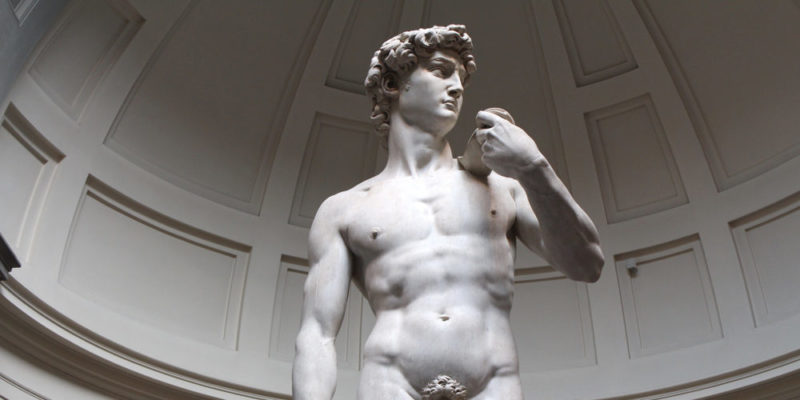We explain what Renaissance art is and its characteristics. Also, painting, sculpture, and architecture of this movement and representatives.
What is Renaissance art?
Renaissance art was an artistic movement that emerged in Italy in the 14th century, during the transition between the Middle Ages and the Modern Age, and was noted for its interest in the wisdom of reason and in the classical values of ancient Greece.
The colonization of America and the end of medieval times changed the understanding of reality. The man began to believe in his own individuality, in his own mind, and in the limitless possibilities of knowledge.
The movement emerged in a context of economic prosperity and the development of new technologies such as the printing press, which had a direct impact on the dissemination of knowledge, the arts, and philosophy. Artists such as Leonardo Da Vinci, Miguel Ángel, and Rafael stood out.
Characteristics of Renaissance art
 Renaissance art went through two main stages:
Renaissance art went through two main stages:
- The Quattrocento (15th century). In this period the constructions of Roman and Greek monuments were investigated and perspective and oil painting were introduced.
- The Cinquecento (16th century). The maturity of the Renaissance period was achieved. The great artists who marked the era emerged, such as Miguel Ángel, Da Vinci, Miguel de Cervantes, Rafael, among others.
Renaissance art was characterized by:
- Recover aspects of classical Greco-Roman culture, such as harmony and proportion as the ideal of beauty, in addition to mythological themes.
- Based on the concept of the human being as the center of all things, instead of considering God as the center of the universe (although Renaissance art took the angels, the apostles, and God as the main figures).
- Weaken the Church, which lost social power in the face of the new conception of reason as the center of everything. The idea of reason prevailed over faith.
- Consider human suffering as a consequence of ignorance. He held that knowledge led to the happiness of man.
- Search for perfection, symmetry, and proportion in the lines, both in painting and sculpture, to represent the human body.
- Consider the plastic arts as a way of expressing knowledge of geometry, mathematics, anatomy, botany, and philosophy.
- Address topics such as mythology, history, the human body, and nature.
- Employ the technique of oil painting in painting on canvas.
- Create the essay, a new genre in literature.
- Incorporate patronage, during this period the important and powerful figures of the time (kings, princes, and nobles) carried out commissions for the decoration of churches or other important constructions.
Renaissance painting
 Renaissance painting was characterized by the perfect representation of details, in terms of balance, harmony, and perspective, based on the artist's observation. The concept of perspective and vanishing point emerged for the conception of spaces.
Renaissance painting was characterized by the perfect representation of details, in terms of balance, harmony, and perspective, based on the artist's observation. The concept of perspective and vanishing point emerged for the conception of spaces.The new oil-on-canvas technique, which prevailed over the classic quick-drying tempera or tempera paint, made it possible to perfect the effect of light and shadow, allowing greater realism to be achieved in portraits and nude bodies.
Artists such as Masaccio, Paolo Uccello, Fra Angélico, Piero Della Francesca and Sandro Botticelli stood out, using various techniques. From the 16th century onwards, the works of Leonardo Da Vinci, Rafael Sanzio, and Miguel Ángel Buonarroti stood out.
Renaissance sculpture and architecture

Renaissance sculpture and architecture were inspired by ancient Greek and Roman cultures, especially for the level of detail and realism. They sought to break with the Gothic style and were based on the perfection of the representations, through mathematical and geometric calculations to obtain real proportions.
In sculpture, the perfectionist and proportional details of the human body were highlighted as artists increasingly acquired knowledge of anatomy, physics, and mathematics, in addition to observation. The works used to be captured in marble and bronze. The most renowned sculptors and architects, among other specialties, were Michelangelo and Donatello.
Representatives of Renaissance art
Among the main representatives of Renaissance art and its most recognized works, the following stood out:
- Andrea Palladio (1508-1580). Architect of the Olympic Theater in Vicenza.
- Dante Alighieri (1265-1321). Writer of The Divine Comedy.
- Donatello (1386-1466). Sculptor of David in bronze.
- Donato d'Angelo Bramante (1443 - 1514). Architect of St. Peter's Basilica.
- Leonardo Da Vinci (1452-1519). Painter of La Gioconda .
- Lorenzo Ghiberti (1378-1455). Architect of the Gate of Paradise, in the Baptistery of Florence.
- Michelangelo (1475 - 1564). Painter of the work in the Sistine Chapel.
- Sandro Botticelli (1445-1510). Painter of The Birth of Venus.
- Fra Angelico (1395-1455). Painter of the Coronation of the Virgin.
Abubakr Conner brings a diverse skill set to our team, and covers everything from analysis to the culture of food and drink. He Believes: "Education is the most powerful weapon that exists to change the world." .
Leave a reply
Your email address will not be published. Required fields are marked *Recent post

Sport: What Is It, Types, Risks, Features, Characteristics and Examples

Dogs: Emergence, Features, Characteristics, Feeding and Breeds

Story: Definition, Elements, Structure, Features and Characteristics

